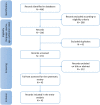Prevalence and determinants of return to work after various coronary events: meta-analysis of prospective studies
- PMID: 36097026
- PMCID: PMC9468005
- DOI: 10.1038/s41598-022-19467-z
Prevalence and determinants of return to work after various coronary events: meta-analysis of prospective studies
Abstract
Return to work (RTW) after a coronary event remains a major concern. This systematic review and meta-analysis of prospective studies published between January 1988 and August 2020, aim to evaluate the prevalence of RTW after a coronary event (myocardial infarction, acute coronary syndrome, angina pectoris) and to assess the determinants of RTW (such as follow-up duration, date of recruitment, country, gender, occupational factors, etc.). PRISMA and MOOSE guidelines were followed. Study quality was assessed using the Newcastle-Ottawa Scale. Random-effects models were carried out to determine pooled prevalence estimates and 95% confident interval. A total of 43 prospective studies (34,964 patients) were investigated. RTW overall random effects pooled prevalence was estimated at 81.1% [95% CI 75.8-85.8]. Country, year of implementation or gender did not significantly modify the prevalence estimates. Lower level of education and degraded left ventricular ejection fraction decreased RTW prevalence estimates (respectively, 76.1% vs 85.6% and 65.3% vs 77.8%). RTW prevalence estimates were higher for white-collars (81.2% vs 65.0% for blue-collars) and people with low physical workload (78.3% vs 64.1% for elevated physical workload).Occupational physical constraints seem to have a negative role in RTW while psycho-logical factors at work are insufficiently investigated. A better understanding of the real-life working conditions influencing RTW would be useful to maintain coronary patients in the labor market.
© 2022. The Author(s).
Conflict of interest statement
The authors declare no competing interests.
Figures





References
-
- Urbinati S, Tonet E. Cardiac rehabilitation after STEMI. Minerva Cardioangiol. 2018;66:464–470. - PubMed

